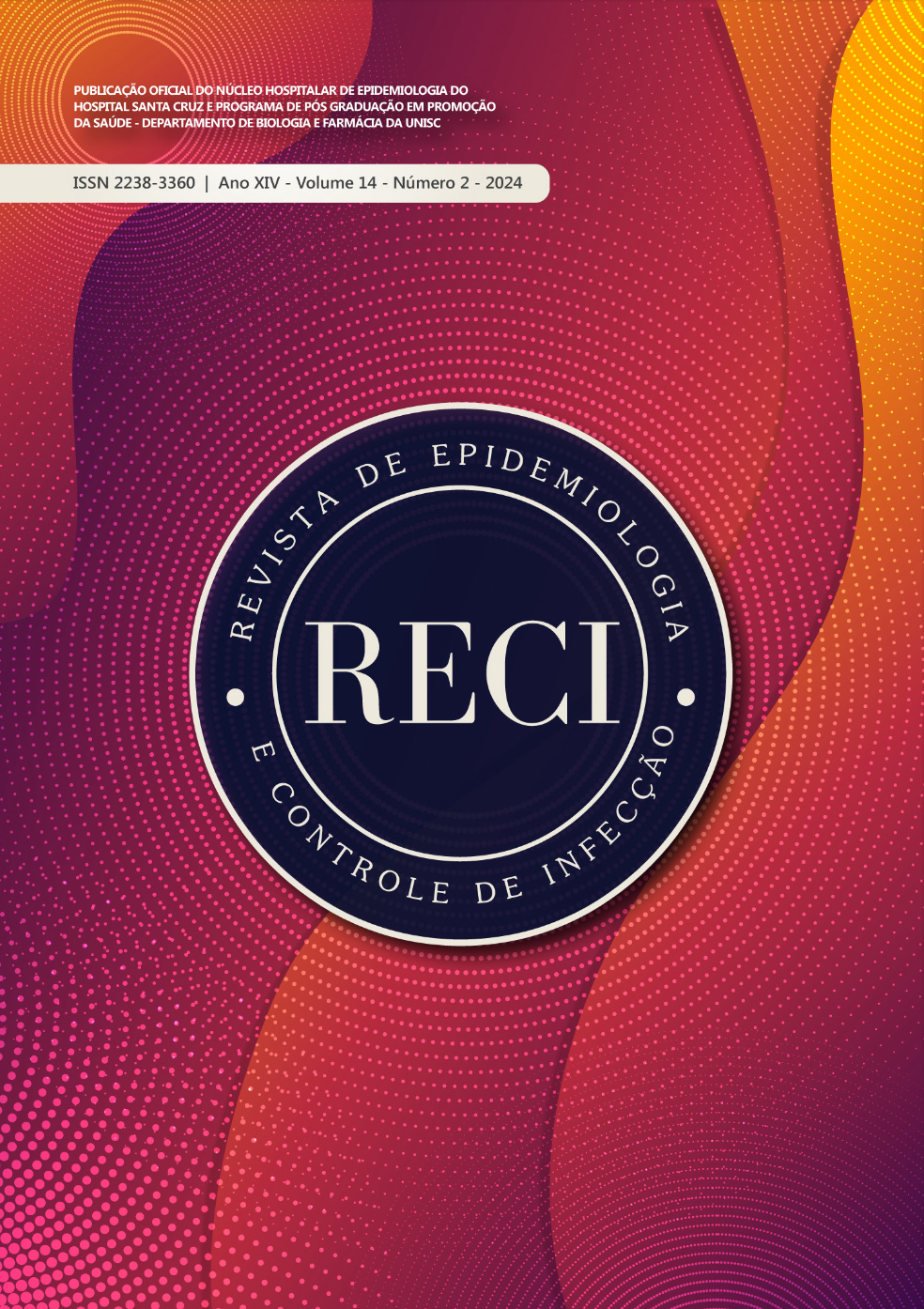Analysis of testing for COVID-19 in Parnaíba city, state of Piauí, from march to December 2020
DOI:
https://doi.org/10.17058/reci.v14i2.18952Keywords:
Coronavirus ; Epidemiology; Testing; Public Health., coronavirus, epidemiology, testing, Public HealthAbstract
Background and Objectives: it is extremely important and necessary to assess epidemiological events through the analysis of measures adopted at the time of crises, especially those with a health impact as a way of improving the system for future events, with testing being a gold standard to be assessed during an epidemic. This study aimed to analyze tests for COVID-19 diagnosis, with a view to detecting possible false negative results, in Parnaíba, Piauí, from March to December 2020. Methods: a statistical analysis of the data reported and made available by the Municipal Health Department using the IBM SPSS Statistics® 21.0 software, in which the variables type of test, date of symptom onset and date of material collection were crossed to obtain the results. Results: a total of 9,473 tests were negative, of which 11.1% were carried out using the RT-PCR methodology, 6.5% using rapid antigen tests, and 82.3% using a rapid antibody test. The analysis revealed that only 0.47% RT-PCR tests and 1.7% rapid antigen tests had been carried out within the ideal testing interval. On the other hand, the rapid antibody test had 0.14% performed outside the range. Conclusion: the most successful diagnostic test was the rapid antibody test, but it is the least specific and not suitable for determining health crisis management policies, especially for isolation measures for infected people, which suggests improvements in testing systems and development of tests with longer and more accurate testing intervals.
Downloads
References
Dutra LC, Guimaraes LMO, Magalhães FMV et al. Avaliação da epidemiologia e da motivação para realização do teste rápido de antígeno durante a pandemia da covid-19. Brazilian Journal of Health and Pharmacy, 2020;4(2). https://doi.org/10.1590/0103-11042020E408
Hachfi W, Lasfar NB. Covid-19: Main therapeutic options. Tunis Med, 2020;98, (4):299-303. https://pubmed.ncbi.nlm.nih.gov/32395792/
Giovanetti M, Benedetti F, Campisi G, Ciccozzi A, Fabris S, Ceccarelli G, Tambone V, Caruso A, Angeletti S, Zella D, Ciccozzi M. Evolution patterns of SARS-CoV-2: Snapshot on its genome variants. Biochem Biophys Res Commun. 2021 29;538:88-91. doi: 10.1016/j.bbrc.2020.10.102.
Liu T, Jianxiong H. Transmission dynamics of 2019 novel coronavirus (2019-nCoV). BioRxiv. 2020. https://dx.doi.org/10.2139/ssrn.3526307
Rong G, Zheng Y, Chen Y, et al. covid-19 diagnostic methods and detection techniques: a review. Ref Modul Biomed Sci. 2021. doi: 10.1016/B978-0-12-822548-6.00080-7
Teixeira MG, Kerr LRFS, Ximeneses RAA, et al. Fortalecer as atividades de informação e vigilância epidemiológica é essencial e urgente para reduzir a força de transmissão do SARS-CoV-2. Revista Brasileira de Epidemiologia. 2021 jun; 24. https://doi.org/10.1590/1980-549720210049
Covid-19 no Brasil: atualização de casos e óbitos confirmados; 2020. Brasília: Ministério da Saúde; 2020. Disponível em: https://covid.saude.gov.br/
Chaibun T, Puenpa J, Ngamdee T, et al. Rapid electrochemical detection of coronavirus SARS-CoV-2. Nat Commun. 2021. Doi: 10.1038/S41467-021-21121-7.
Li Z, Yi Y, Luo X, et al. Development and Clinical Application of A Rapid IgM‐IgG Combined Antibody Test for SARS‐CoV‐2 Infection Diagnosis. Journal of Medical Virology. 2020 fev; 92(9):1518-1524. Doi: 10.1002/jmv.25727.
Magno L, Rossi TA, Mendonça-Lima FW, et al. Desafios e propostas para ampliação da testagem e diagnóstico para covid-19 no Brasil. Ciência & Saúde Coletiva. 2020 ago; 25: 3355–3364. https://doi.org/10.1590/1413-81232020259.17812020
Chen N, Zhou M, Dong X, et al. “Epidemiological and clinical characteristics of 99 cases of 2019 novel coronavirus pneumonia in Wuhan, China: a descriptive study.” Lancet, London-England. 2020; 395,(10223): 507-513. Doi: 10.1016/S0140-6736(20)30211-7.
Oliveira BA, Oliveira LC, Sabino EC, et al. SARS-CoV-2 and the covid-19 disease: a mini review on diagnostic methods. Revista do Instituto de Medicina Tropical de São Paulo. 2020; 62. doi: 10.1590/S1678-9946202062044
Chavda VP, Vuppu S, mishra T, et al. Recent review of covid-19 management: diagnosis, treatment and vaccination. Pharmacol Rep. 2022 Dec;74(6):1120-1148. doi: 10.1007/s43440-022-00425-5.
Castro, R. et al. covid-19: a meta-analysis of diagnostic test accuracy of commercial assays registered in Brazil. The Brazilian Journal of Infectious Diseases, marc. 2020; 24 (2): 180–187. http://doi.org/10.1016/jbjid.2020.04.003.
Garcia LP, Gonçalves AV, Andrade MP, et al. Estimating underdiagnosis of covid-19 with nowcasting and machine learning. Revista Brasileira de Epidemiologia. 2021,24. https://doi.org/10.1590/1980-549720210047
Hosseini ES, Kashani NR, Nikzad H, et al. “The novel coronavirus Disease-2019 (covid-19): Mechanism of action, detection and recent therapeutic strategies.” Virology. 2020;551: 1-9. doi: 10.1016/j.virol.2020.08.011.
Brasil. Ministério da Saúde. Guia de Vigilância Epidemiológica Emergência de Saúde Pública de Importância Nacional pela Doença pelo Coronavírus 2019. Vigilância Integrada de Síndromes Respiratórias Agudas Doença pelo Coronavírus 2019, Influenza e outros vírus respiratórios. Brasilia: Ministério da Saúde; 2019. https://www.gov.br/saude/pt-br/centrais-de-conteudo/publicacoes/svsa/coronavirus/guia-de-vigilancia-epidemiologica-covid-19_2021.pdf/view
Downloads
Published
How to Cite
Issue
Section
License
Copyright (c) 2024 Dénis Miguel Rodrigues de Oliveira, Anna Carolina, Deyseane Zacarias Freire de Sousa, Gustavo, Karliane de Araújo Lima, Paloma Maria de Sousa Araujo, Vanessa Poleana Silva

This work is licensed under a Creative Commons Attribution 4.0 International License.
The author must state that the paper is original (has not been published previously), not infringing any copyright or other ownership right involving third parties. Once the paper is submitted, the Journal reserves the right to make normative changes, such as spelling and grammar, in order to maintain the language standard, but respecting the author’s style. The published papers become ownership of RECI, considering that all the opinions expressed by the authors are their responsibility. Because we are an open access journal, we allow free use of articles in educational and scientific applications provided the source is cited under the Creative Commons CC-BY license.


